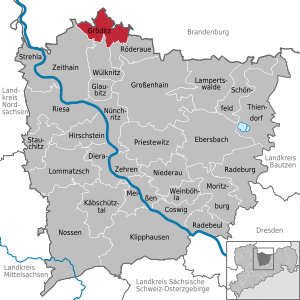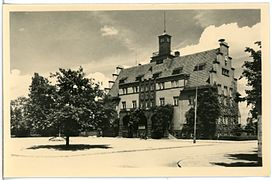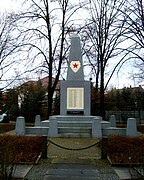Gröditz
| coat of arms | Germany map | |
|---|---|---|

|
Coordinates: 51 ° 25 ' N , 13 ° 27' E |
|
| Basic data | ||
| State : | Saxony | |
| County : | Meissen | |
| Height : | 95 m above sea level NHN | |
| Area : | 28.94 km 2 | |
| Residents: | 6978 (Dec. 31, 2019) | |
| Population density : | 241 inhabitants per km 2 | |
| Postal code : | 01609 | |
| Area code : | 035263 | |
| License plate : | MEI, GRH, RG, RIE | |
| Community key : | 14 6 27 050 | |
| LOCODE : | DE GTZ | |
| City structure: | 6 districts | |
City administration address : |
Reppiser Strasse 10 01609 Gröditz |
|
| Website : | ||
| Mayor : | Jochen Reinicke (independent) | |
| Location of the city of Gröditz in the district of Meißen | ||
Gröditz is a small town in the district of Meißen in Saxony in the Röderaue between Riesa and Elsterwerda .
geography
Gröditz lies on a low plain around 100 meters high, through which the Großer Röder flows. The city lies on the Saxon side of today's Saxon- Brandenburg border and the former Saxon- Prussian border . The Elsterwerda-Grödel-Floßkanal ( Floßgraben ) runs through Gröditz, which was created to supply the Dresden-Meißner Elbe Valley with wood from the Schradenwald and later became a location-promoting link between the Riesa , Gröditz and Lauchhammer iron processing plants . In 1947 shipping was stopped.
In addition to the core city, Gröditz also includes the districts of Nauwalde , Nieska , Reppis , Spansberg and Schweinfurth .
history
Gröditz was first mentioned in a document in 1363, but it has existed since at least the late 12th century and was inhabited by Slavs. The Röderaue itself, in which Gröditz is located, has been inhabited since the 1st century. The place name is derived - as in Gröditz in Upper Lusatia - from the Sorbian word grod for "castle".
The street village belonged to the Saathain rule . The castle, located five kilometers to the north and once located in Saathain in Brandenburg , of which only ruins, the park and the manor church can be seen today, is one of the oldest fortifications on the Black Elster . Until the middle of the 14th century it belonged to the Naumburg Abbey as an imperial loan . In addition to Gröditz and Saathain, the towns of Stolzenhain , Schweinfurth , Reppis and Mühldorf, which was incorporated in Kröbeln in 1935 , also counted .
Between 1742 and 1748, under the Elector of Saxony, Friedrich August II, the Elsterwerda-Grödel raft canal was built , a shipping route operated by Bomätscher ( towers , ship pullers). The hydraulic structure leading through Gröditz ultimately formed the basis for the later industrialization of the local situation of Gröditz. Count Detlev Carl von Einsiedel , who among other things inherited the Saathain rule, acquired the Gröditzer mill in 1779 and founded the Gröditzer ironworks (Lauchhammerwerk) at this location. In 1825 the foundation stone was laid for the construction of a blast furnace, which was put into operation in 1827.
The community of Gröditz, which previously only consisted of a few houses, grew, as did some of the surrounding communities, primarily as a result of the steelworks located here, which led to further industrial settlements. In 1836 Gröditz only had 150 inhabitants, shortly before the Elsterwerda – Riesa railway line was built , there were already 545.
During the Second World War there was a forced labor camp in the Lauchhammer works of the Central German steelworks of the Flick Group , in which 4,000 prisoners of war as well as women and men from the countries occupied by Germany had to do forced labor in gun production. From September 27, 1944 to April 17, 1945, there was a satellite camp of the Flossenbürg concentration camp with more than 1,000 concentration camp prisoners , including 260 Jews . The extremely inhumane living conditions led to the death of at least 220 prisoners. Shortly before the end of the war on April 17, 1945, a massacre occurred in a quarry not far from the small community of Koselitz , which was carried out on 188 inmates of the camp when American forces were only about eighteen kilometers from Gröditz.
The growth of the community continued and finally on October 5th, 1967 Gröditz received city rights. For the following year 1968, Gröditz had 8100 inhabitants and the population continued to grow until the end of the 1980s to over 10,000.
On May 25, 2009, the city received the title “ Place of Diversity ” awarded by the federal government .
- Gröditz 1955
Incorporations
On October 1, 1928, the neighboring village of Reppis in the north of Gröditz was incorporated. On January 1, 2013, the neighboring municipality of Nauwalde was incorporated , which had been a member of the Gröditz administrative community since 2000 .
Population development
| year | Residents |
|---|---|
| 1682 | 152 |
| 1836 | 150 |
| 1848 | 170 |
| 1871 | 545 |
| 1890 | 954 |
| 1900 | 1,469 |
| 1936 | 3,500 |
| 1945 | 4,303 |
| year | Residents |
|---|---|
| 1946 | 5,406 |
| 1968 | 8,100 |
| 1987 | 10,436 |
| 1990 | 10,059 |
| 1994 | 9,265 |
| 1998 | 8,878 |
| 2003 | 8,081 |
| 2007 | 7,534 |
| year | Residents |
|---|---|
| 2009 | 7,244 |
| 2011 | 6,970 |
| 2013 | 7,524 |
politics
City council
The local election on May 25, 2014 led to the following result with a turnout of 46.2% (+ 4.8):
| Party / list | Share of votes | +/- | Seats |
| CDU | 29.1% | + 0.4 | 5 |
| BGV | 20.2% | New | 4th |
| The left | 17.5% | - 1.0 | 3 |
| FWV Gröditz | 17.1% | - 1.1 | 3 |
| SPD | 16.1% | - 5.9 | 3 |
mayor
The non-party Jochen Reinicke was elected mayor of Gröditz in June 2008 and confirmed in office in June 2015.
coat of arms
The Gröditz city arms from 1982 is divided into four parts: Field 1 in red a golden (yellow) ear of wheat, field 2 in gold (yellow) a black anvil with hammer, field 3 in blue a golden (yellow) French lily, field 4 in silver (white ) a red rose.
The ear of wheat symbolizes the agrarian surrounding area, hammer and anvil the iron processing that dates back to 1780. Historical ownership is symbolized by the lily (line from Köckeritz ) and the rose (line from Schleinitz ).
Town twinning
Since 1969 there has been a town partnership with Jarny in France . An intra-German partnership with Linkenheim-Hochstetten has existed informally since 1984 (first meeting of the mayors), and formally since 1990.
Culture and sights
- see also: List of cultural monuments in Gröditz
Buildings
- Evangelical Church of Gröditz
- Spansberg village church
- Nauwalde village church
- Elsterwerda-Grödel raft canal
- Gröditz town hall
- Water tower
- Boundary stone on the former border between Saxony and Prussia from 1815
- Hotel "Spanischer Hof"
- Buildings in Gröditz
Memorials
There are various memorial sites in Gröditz: for Gröditz victims of wars and dictatorships at the memorial square, for war victims of the Soviet Army (Reppiser Strasse) and for perished concentration camp prisoners and forced laborers at the Südrand Stahlwerk. A grave and memorial from 1946 for 47 Soviet prisoners of war and 16 concentration camp inmates who fell victim to forced labor during World War II , as well as a memorial stone from 1991 for Italian military internees, are located on the premises of the Lauchhammerwerke.
- Memorial sites in Gröditz
Culture
- Cinema Castello
Economy and Infrastructure
Companies
Schmiedewerke Gröditz GmbH / Stahlguss Gröditz GmbH
In 1779, Count Detlev Carl von Einsiedel founded the Gröditzer ironworks, which, with the construction of a blast furnace, was the leading manufacturer of pipes for water and gas lines as early as 1827. After the Second World War, the company was founded in 1948 under the name VEB steel and rolling mill Gröditz as a state-owned enterprise nationalized. In 1954 the reconstruction phase ended with the commissioning of a 60 MN forging press. After the reunification in 1990, the company was re-established under the name Gröditzer Stahlwerke GmbH . In 1997 the Georgsmarienhütte Holding GmbH took over the company, two years later the operational areas Edelstahl Gröditz and Stahlwerk Gröditz were founded, which in 2002 resulted in the privatization of Schmiedewerke Gröditz GmbH and Elektrostahlwerke Gröditz GmbH. In 2004 the steel foundry was renamed Stahlguss Gröditz GmbH and became an independent company of Georgsmarienhütte Holding GmbH. This company was closed in mid-2015 after the last batch of castings had been poured on March 5, 2015. Schmiedewerke Gröditz manufacture open-die forgings and ring rolled products on their own steel basis.
At the end of 1989 there were 5,600 employees in the Gröditz steelworks. In 2008 the GMH Group companies based in Gröditz employed a total of 823 people.
Pulp mill
In 1883 the Kübler & Niethammer company founded a sulphite pulp factory in Gröditz. On May 15, 1884, the production of sulphite pulp started. The company had 250 employees. In 1940 a new fuel factory was put into operation, which produced raw alcohol from the liquor in the cooking facility. The annual production reached 39,000 tons of pulp. In 1946 the company was transferred to public ownership. On January 1, 1991, production in the pulp mill was stopped. In 1992 the acid tower was blown up, from 1993 to 1995 Stahlhandel Gröditz GmbH used the old pulp factory to expand the business area of quality and stainless steel blanks. In 1997 the power plant and chimney were demolished.
Stahlhandel Gröditz GmbH
In 1993 Stahlhandel Gröditz GmbH moved into the old pulp mill and manufactured sawn steel blanks for customers from Gröditz and the surrounding area. Since the premises were no longer sufficient for the requirements, managing director Michael Voss decided to continue the steel trade in the Gewerbering in Gröditz. Due to the further positive development, the first sawing center was opened at the Zeithain location in 2005 . From 2007, trade fair appearances followed. With now more than 5,000 customers in 82 countries, space had to be created for additional jobs at the freight station in Gröditz in 2013. The expansion of the production capacities in Zeithain was realized in 2014 with the relocation of the sawing center to a larger hall with 12,000 square meters.
Oschatz first and children's clothing factory, Gröditz branch
From 1972 to 1990 there was a branch (sewing) of the VEB Erstlings- und Kinderbekleidungswerk Oschatz (EKO) in Gröditz with around 230 employees at the end. The finished textiles were also delivered to the Soviet Union and “ non-socialist countries ”, including to C&A . The REWE Center is now located on this site.
education
The city of Gröditz has two schools and four day-care centers.
With currently ten classes and over 200 students, the Gröditzer elementary school is one of the largest in the district of Meißen. The school building, built in 1954, was given a gym extension in 1971. The school offers open all-day offers for grades 3 and 4. There are specialist cabinets for the subjects religion, ethics, art education, language of encounter, music, as well as local and regional studies.
Another school in the city is the "Siegfried Richter" high school, which offers various all-day offers. The school was built in 1980 and on December 13, 1982 was named Polytechnic High School " Armin Walter ". After the German reunification , the school was converted into a middle school and in 2013 into a high school and extensively renovated from 2000 to 2003. Since August 10, 2001 it has been named after Siegfried Richter, honorary citizen of Gröditz who died on September 27, 2000 . The school's friends' association, founded on April 9, 1997, currently has around 160 members and has hired a recreational pedagogue to look after the children and young people since 1997.
From 1968 to 2003 there was another school (POS, later middle school), which from 1979 was called "Sigmund Jähn". The prefabricated school building on Wainsdorfer Straße was demolished in 2006 and a green area with play facilities was designed on the demolished wasteland.
traffic
The station Gröditz is located on the zeithain-elsterwerda railway . Gröditz is crossed by the federal highway 169 , which leads from Neuensalz via Chemnitz , Riesa , Gröditz, Elsterwerda and Senftenberg to Cottbus . In addition, the federal highway 101 , which leads from Berlin to Aue , runs directly past Gröditz.
Personalities
Honorary citizen
- Siegfried Richter (1922–2000), entrepreneur
- Kurt Biedenkopf (* 1930), lawyer, university professor and politician (CDU), Prime Minister of Saxony 1990–2002
sons and daughters of the town
- Klara Elisabeth Karg-Gasterstädt (1886–1964), Germanist, teacher
- Johannes Schütze (1911 – after 1972), politician
- Klaus Sammer (* 1942), soccer player and coach
- Dieter Riedel (* 1947), soccer player and coach
Other personalities associated with the city
- Pierre Villeminot (1913–1945), French writer and resistance fighter. He was an inmate of the Gröditz forced labor camp and died in the massacre on April 17, 1945 in Koselitz.
literature
- Mathias Antusch: Forced labor in the Gröditz steelworks. Institute for the History of the University of the Federal Armed Forces Munich, Neubiberg 2004, ISBN 3-638-59402-5 .
- Cornelius Gurlitt : Gröditz . In: Descriptive representation of the older architectural and art monuments of the Kingdom of Saxony. 37. Issue: Amtshauptmannschaft Grossenhain (Land) . CC Meinhold, Dresden 1914, p. 100.
- Egon Förster: Forced laborers in Gröditz 1939–1945. Gröditz 2004, OCLC 845380105 .
- Paul Namyslik: Chronicle of the Röderstadt Gröditz. Meißner Tageblatt Verlags GmbH, Nieschütz 2005, ISBN 3-929705-11-7 .
- Paul Namyslik: Chronicle of the Röderstadt Gröditz 2005 to 2010. Gröditz 2010, ISBN 978-3-00-032776-6 .
- Paul Namyslik: 800 years of Gröditz 1217–2017: Chronicle of the city. Gröditz 2016, DNB 1129631915 .
- Siegfried Richter: The courage-maker. A Saxon returns home. Self-published, Gröditz 1999, ISBN 3-00-004177-X .
- Cities publisher E. v. Wagner & J. Mitterhuber GmbH (ed.): Gröditz - information brochure for citizens and guests with a multi-colored city map. ( online ; PDF; 5.8 MB)
- Gröditz, Saxony: Pictures tell. Horb am Neckar 1993, ISBN 3-89264-807-7 .
- Gröditz, city map 1: 7.500. City publisher Fellbach, 1999, ISBN 3-8164-5255-8 .
- Gröditz. Topographic map 1: 25,000. Land survey office Brandenburg, 1994, ISBN 3-7490-3303-X .
Web links
- Internet presence of the city of Gröditz
- Gröditz in the Digital Historical Directory of Saxony
- Reppis in the Digital Historical Directory of Saxony
Individual evidence
- ↑ Population of the Free State of Saxony by municipalities on December 31, 2019 ( help on this ).
- ^ A b Fritz Siefert, Manfred Weisbrod: The Lexicon of German Cities . XENOS, 1993, ISBN 3-8212-1258-6 , pp. 269 .
- ↑ a b c K. Mende: The Elsterwerda-Grödel raft canal and its formation . In: The Black Magpie . No. 167-169 , 1912 (local history supplement to the Liebenwerdaer Kreisblatt).
- ↑ Gröditz in the Digital Historical Directory of Saxony , accessed on March 12, 2014.
- ↑ Gröditz satellite camp , Flossenbürg Concentration Camp Memorial website, accessed on April 26, 2017.
- ↑ Gröditz in the Digital Historical Directory of Saxony , accessed on March 12, 2014.
- ↑ earnings in 2014 , results for 2009 , Statistical Office of the Free State of Saxony
- ↑ Mayoral election 2015 on statistik.sachsen.de, accessed on April 26, 2017.
- ↑ Gröditz , online project fallen memorials on denkmalprojekt.org, accessed on April 26, 2017.
- ^ Website of the Siegfried Richter Oberschule , accessed on April 26, 2017.














